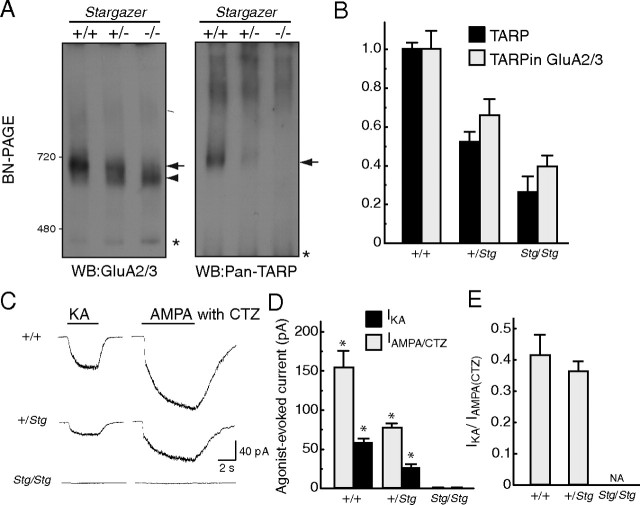Figure 5.
Neuronal AMPA receptors associated with one TARP/stargazin. Primary cerebellar granule cell cultures were prepared from littermates of wild-type (+/+), heterozygous (+/Stg), and homozygous (Stg/Stg) stargazer mice. A, Neurons were solubilized and resolved on 3–8% BN-PAGE. Two predominant bands of GluR2/3 in neurons from wild-type (left, arrow) and stargazer heterozygous (left, arrow and arrowhead) and homozygous (left, arrowhead) mice were observed on BN-PAGE. Stargazin was expressed in a copy-number-dependent manner (right, arrow). A single band of stargazin was detected in neurons from wild-type and heterozygous neurons, but not in neurons from homozygous stargazer mice. The asterisks indicate nonspecific bands, one of which could be GluA2/3 dimers. B, The signal intensity of GluA2/3 and stargazin bands in neurons from wild-type and stargazer heterozygous and homozygous mice was quantified using the ImageJ software and was normalized to the wild type. Importantly, the increase in the number of stargazin copies led to the concordant up-regulation of the AMPA receptor/TARP complex signal, which suggests a fixed stoichiometry of stargazin on AMPA receptors in neurons. C–E, Agonist-evoked whole-cell currents were measured in cultured mouse cerebellar granule cells. The steady-state currents evoked by 20 μm kainate (IKA) or 100 μm AMPA with 100 μm cyclothiazide (CTZ; IAMPA/CTZ) increased linearly in a stargazin copy-number-dependent manner. The representative traces (C), mean steady-state amplitude (D), and ratio of agonist-evoked currents (E) for each genotype are shown. Data represent the mean ± SEM (n = 4–5). Asterisks indicate p < 0.01 using Tukey's test with ANOVA, a significance difference of IKA or IAMPA/CTZ between wild-type and stargazer heterozygous or between stargazer heterozygous and homozygous. WB, Western blotting.

